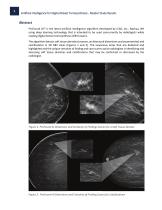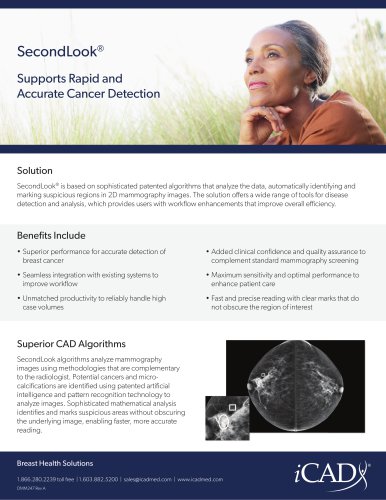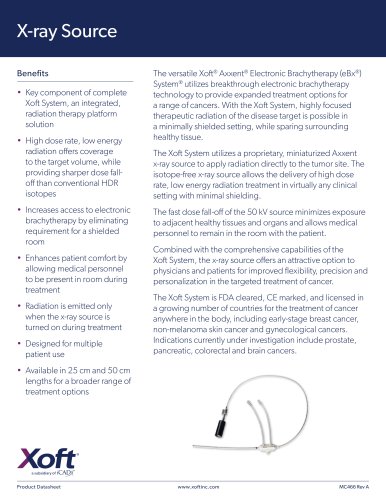 Website:
iCAD
Website:
iCAD
Catalog excerpts

White Paper Artificial Intelligence for Digital Breast Tomosynthesis - Reader Study Results WHITE PAPER
Open the catalog to page 1
Artificial Intelligence for Digital Breast Tomosynthesis - Reader Study Results Abstract ProFound AI™ is the latest artificial intelligence algorithm developed by iCAD, Inc., Nashua, NH using deep learning technology that is intended to be used concurrently by radiologists while reading digital breast tomosynthesis (DBT) exams. The algorithm detects soft tissue densities (masses, architectural distortions and asymmetries) and calcifications in 3D DBT slices (Figures 1 and 2). The suspicious areas that are detected and highlighted and the unique certainty of finding and case scores assist...
Open the catalog to page 2
Artificial Intelligence for Digital Breast Tomosynthesis - Reader Study Results Introduction The addition of DBT to full-field digital mammography (FFDM) improves radiologist performance by increasing cancer detection rates [1-4] and lowering recall rates [2-7], but also increases reading time almost two-fold [1, 8, 9], compared to 2D alone. Thus, ProFound AI was designed to maintain or improve radiologist clinical performance, while significantly reducing reading time. Materials and Methods Study Design A retrospective, fully-crossed, multi-reader, multi-case (MRMC) clinical reader study...
Open the catalog to page 3
Artificial Intelligence for Digital Breast Tomosynthesis - Reader Study Results Objectives The objectives of the reader study were the following: A. Co-primary objectives. The co-primary objectives were to determine: 1. Whether radiologist performance when using ProFound AI with DBT images is noninferior to radiologist performance when reading DBT images without ProFound AI, and 2. Whether radiologist reading time when using ProFound AI with DBT images is superior to (shorter than) radiologist reading time when reading DBT images without ProFound AI. Radiologist performance was assessed by...
Open the catalog to page 4
Estimates and corresponding 95% confidence intervals illustrating precision in the estimates were provided for all secondary objectives. The study employed a fully-crossed design in which all readers reviewed images from all cases in two visits separated by a memory washout period of 4 weeks or more between readings of the same case with and without ProFound AI. Each reader was assigned to review half the cases with ProFound AI and the other half without ProFound AI during the first visit and the complementary with and without ProFound AI cases during the second visit, in a counterbalanced...
Open the catalog to page 5
Artificial Intelligence for Digital Breast Tomosynthesis - Reader Study Results Figure 4. Use of Concurrent DBT ProFound AI System In addition to superiority of case-level AUC, evaluation of the secondary endpoints of the reader study demonstrated the following: • Radiologists had superior sensitivity at the case level with ProFound AI. Average sensitivity increased by 0.080 (95% CI: 0.026, 0.134; non-inferiority p < 0.01 for noninferiority margin delta = 0.05, and p < 0.01 for test of difference). Average case-level sensitivity was 0.770 without ProFound AI and 0.850 with ProFound AI. At...
Open the catalog to page 6
Artificial Intelligence for Digital Breast Tomosynthesis - Reader Study Results • • • Average specificity decreased by 0.027 (SE=0.038) in the subgroup of 24 benign and recalled (non-cancer) cases with only calcifications. Average specificity increased by 0.079 (SE=0.028) in the subgroup of 62 benign and recalled (non-cancer) cases with at least one soft tissue density or mixed lesion. Average specificity increased by 0.084 (SE=0.021) in the subgroup of 109 non-cancer cases with no lesions. References [1] Skaane P, Bandos AI, Gullien R, et al. Comparison of digital mammography alone and...
Open the catalog to page 7
Artificial Intelligence for Digital Breast Tomosynthesis - Reader Study Results © 2018, iCAD Inc. All rights reserved. iCAD, the iCAD logo and ProFound AI are trademarks of iCAD, Inc. Reproduction of any of the material contained herein in any format or media without the express written permission of iCAD, Inc. is prohibited
Open the catalog to page 8All ICAD catalogs and technical brochures
-
ProFound AI®
2 Pages
-
VeraLook®
2 Pages
-
PowerLook® Platform
1 Pages
-
SecondLook®
1 Pages
-
Radion Hub – Peer Review
2 Pages
-
Axxent® Hub
2 Pages
-
Physics Accessories Kit
2 Pages
-
Surface Applicators
2 Pages
-
Cervical Applicator
2 Pages
-
Vaginal Applicators
2 Pages
-
Rigid Shield
2 Pages
-
Balloon Applicators
2 Pages
-
Controller
2 Pages
-
X-ray Source
2 Pages



















